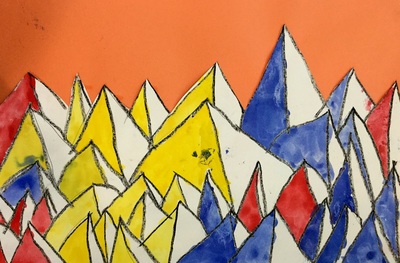|
2nd grade took a look at contemporary British artist, Damien Hirst. Damien has a wide variety of art but we focused on his spin paintings. Hirst has a table that spins in a circular motion. He puts paint onto the table and as it spins, it moves the paint around. Sometimes he takes the spin paintings and then cuts them into new shapes like the butterfly above. 2nd grade learns about butterflies in their classroom so I thought this would be a good tie in.
Although we don't have a spinning table, we used paper plates instead to create our spin paintings. Each student was given 2 plates. They used the primary colors and applied the paint thickly to their plate. Then they flipped their plate over onto a sheet of paper, pressed their finger in the center of the plate, and then rotated it. As the plate rotated, the primary colors mixed and created the secondary colors. The kids thought this was the raddest thing EVER! The next day, we took our 2 spin paintings and traced a circle around the edge of the paintings. Students cut out that circle and folded it in half so it looked like a taco. We then talked about symmetry and how a butterflies wings are the same on both sides. I showed them how to paint half of a butterfly with black paint and then fold their paper in half to print the other side of it. The last day, we cut out and glued our two butterflies down onto a strip of paper. I think doing it this way turned out better than how I did it last year. Last year, I had the kids try to paint the symmetry rather than just fold it in half and print it.
0 Comments
Here are some photos of our Alexander Calder project this year and my write up from last year to go with it.
2nd grade took a look at contemporary British artist, Damien Hirst. Damien has a wide variety of art but we focused on his spin paintings. Hirst has a table that spins in a circular motion. He puts paint onto the table and as it spins, it moves the paint around. Sometimes he takes the spin paintings and then cuts them into new shapes like the butterfly above. 2nd grade learns about butterflies in their classroom so I thought this would be a good tie in.
Although we don't have a spinning table, we used paper plates instead to create our spin paintings. Each student was given 3 plates. They used the primary colors and applied the paint thickly to their plate. Then they flipped their plate over onto a sheet of paper, pressed their finger in the center of the plate, and then rotated it. As the plate rotated, the primary colors mixed and created the secondary colors. The kids thought this was the raddest thing EVER! The next day, we took our 3 spin paintings and traced a circle around the edge of the paintings. Students cut out that circle and folded it in half so it looked like a taco. We then talked about symmetry and how a butterflies wings are the same on both sides. I showed them how to draw half of a basic butterfly and cut it out. They were welcome to make more complicated butterflies. They thought it was awesome that after cutting it out and unfolding the plate, they now had a full butterfly! For future purposes, I need to find a more effective way of teaching how to draw a butterfly. The last day, we glued our three butterflies down onto a strip of paper. Then we used black paint to paint lines and shapes onto the wings, focusing on making them symmetrical. Alexander Calder was an American artist who is most well-known for his large metal mobiles that hang from ceilings. We took a look at his paintings instead and I was pleased to hear that the first thing my artists noticed was his use of the primary colors!
We kicked off the project by drawing triangles on our paper. I emphasized that their triangles needed to start at the bottom of their paper and gradually work their way up. After drawing each triangle, students drew another line diagonally downwards from the triangle's peak which created a pyramid-like effect. Students quickly noticed that by working from the bottom up, it created the illusion of space from all of the overlapping. After they finished drawing, they traced everything with a black crayon. On the second day of class, we cut out our triangles/mountains. Then we painted using the primary colors. With our paintings, we only ended up painting one side of each triangle. This created an effect like light was hitting one side of the triangle. Lastly, we glued our paintings down to a secondary colored background. It got a little messy because students were gluing down wet paintings but I didn't want to spend another class period just to cut them out and glue them to their backgrounds. |
Devon CalvertHarmony and Consolidated Elementary Art Teacher in Milton, WI. UW-Eau Claire graduate. WAEA President. Apple Teacher. Archives
March 2019
Categories
All
|





















 RSS Feed
RSS Feed
